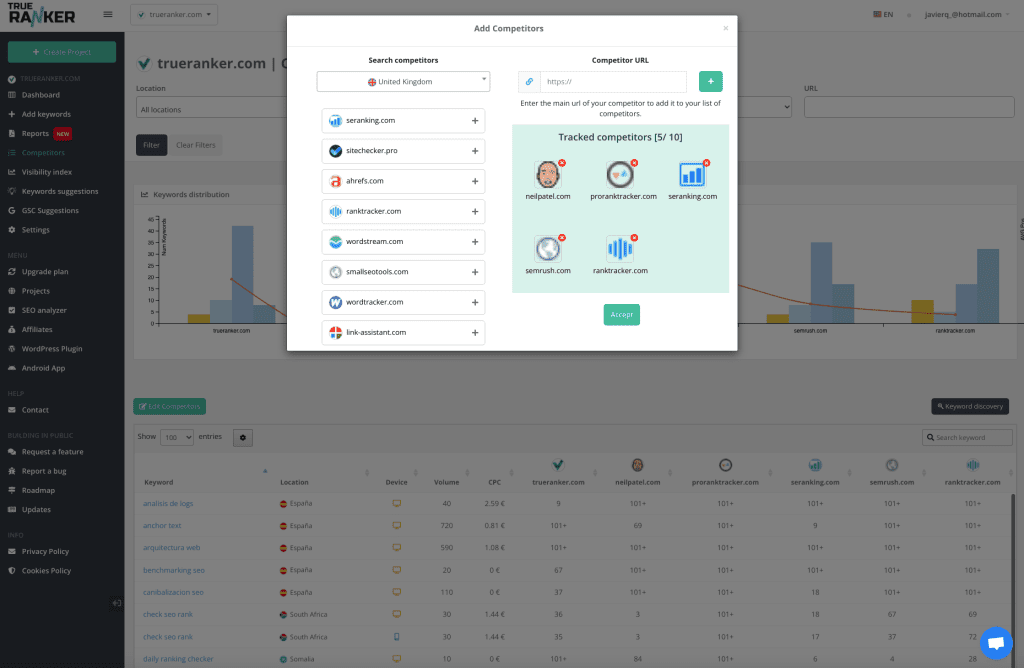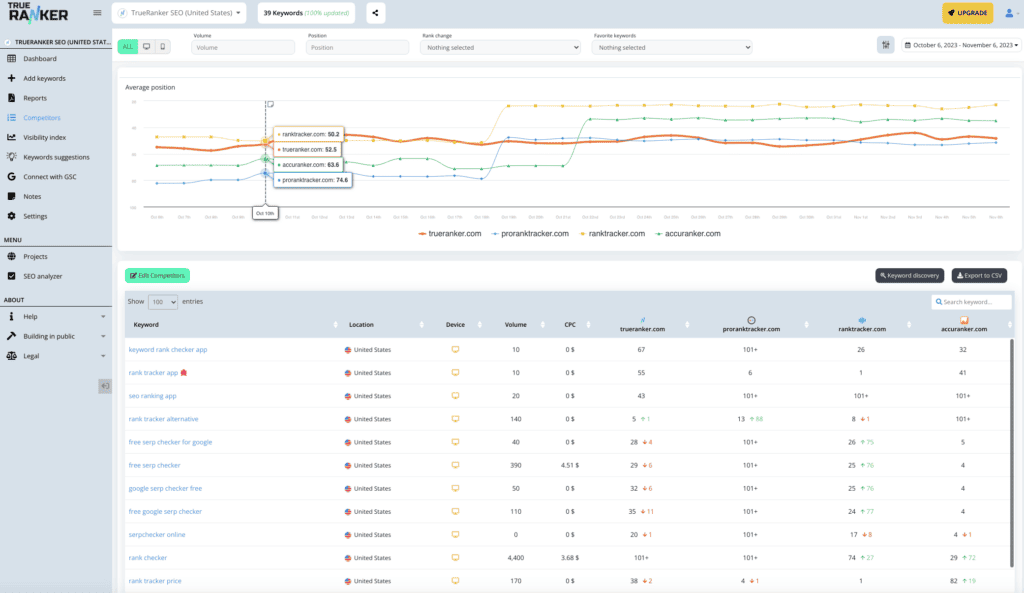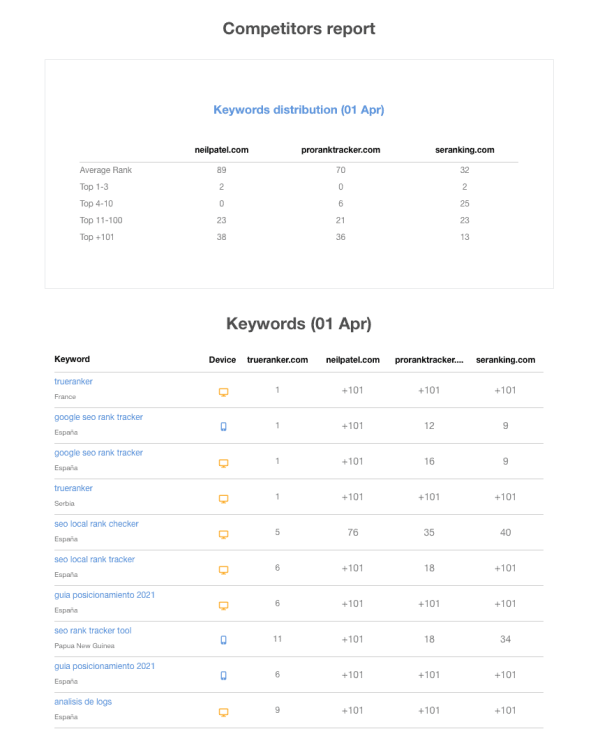Benchmarking is a tool that companies use to study their competitors or companies that are doing really well, in order to discover their strategies and processes to be able to apply them in their own business.
SEO benchmarking is a very interesting practice to find out how other websites are positioning themselves and why they are in the first positions of Google’s results pages. With this information, changes can be applied to the web to optimize it and improve its positioning.
What is an SEO Benchmarking?
SEO benchmarking consists of a study of the website itself, competing sites, and other pages that have a good web positioning, to discover their positioning strategies and techniques, to apply them to the own website.
When a company bets on benchmarking focused on SEO, it manages to design and implement better positioning strategies to achieve better positions in Google’s SERPs.
In an SEO benchmarking process, the following websites are studied and analyzed:
- Internal analysis. An SEO audit of the website itself to discover its strengths, weaknesses, threats, and opportunities (like a marketing SWOT analysis, but focused on SEO).
- Direct competition. Analysis of the SEO strategies and techniques of the websites with which you compete directly.
- Industry-leading sites. Analysis of the pages of the sector that occupy the first positions in Google.
- Reference pages. Analysis of websites that are in the first positions of Google, but that is not related to the theme or activity of the web.
How to do an SEO Benchmarking
Carrying out an SEO benchmarking process requires a lot of dedication and time. It is not a simple process because there are many factors and aspects to analyze to obtain really useful results that can be used to improve web positioning. Here are the steps to follow on how to do an ideal SEO benchmarking:
1. Define what is to be measured or evaluated
The first step to do SEO Benchmarking is to define what is going to be measured. The greater the number of variables and factors that are evaluated, the higher the quality of the information and the analysis that is carried out.
Some of the points that should be covered in an SEO benchmarking are:
- Keyword Research. Knowing the keywords by which competitors or well-positioned pages are positioned will allow a better selection of words for the web, detect positioning opportunities by derived keywords, identify words that are difficult to position, etc.
- Study of web traffic. It is important to know the traffic generated by competitors’ sites to be able to assess how popular they are and compare it with your own.
Backlink analysis. Knowing the links that point to the websites of the competition will be able to know their authority and discover sites where to get quality backlinks. - Study of the contents. With a study of the content of the competitors, you can obtain a lot of useful information for SEO. For example, the topics they deal with, how they structure the texts, what type and where they place the call to action, where they link from the content, what anchor text they use in the links or the usual length of their texts, among many others.
Low-cost Competitor Rank Tracker
2. Analysis of our website
It is also necessary to carry out an in-depth study and analysis of your own website to know how it is optimized for search engines.
This point is very important in the SEO benchmarking process as it will allow a later comparison with the competition.
With the internal SEO audit you will be able to discover:
- Strengths. Things that are being done well, in order to maintain them and continue to enjoy the benefits they provide.
- Weaknesses. Those things are not well optimized on the web and need to be replaced, improved, or enhanced.
- Threats. The actions that are being carried out and that may pose a threat to the positioning (duplicate content, key stuffing, broken links …).
- Opportunities. Identify processes or elements that can help improve web positioning (a specific URL with a lot of web traffic, for example).
3. Who are my competitors?
SEO benchmarking focuses mainly on analyzing competitor websites in order to compare them with your own, although a study can also be carried out of other websites that are not competition, that are doing things well in relation to their web positioning.
Before starting to analyze websites, it is necessary to establish which competitors are more interesting to investigate. With a good choice, better results can be obtained and the resources used in the process will be optimized (avoiding losses of time, effort, and even money).

Thanks to tools like TrueRanker you can find out who your main SEO competitors are without having to do a lot of analysis.
In the tool’s competitor module, it will give you the domains that are competing with you for the most keywords in your sector.
4. SEO analysis of competitors
Once the competing websites to be analyzed in the SEO benchmarking process have been chosen, specific tools must be used to speed up and facilitate the work (tools based on automation).
By studying the competition you can reach conclusions about web positioning and the actions to be followed.
My Competitor's Google Positions VS My Positions
One of the aspects that must be analyzed and compared is the position of the competitors’ website with their own. This process should not only be done for the main web address, but for different URLs of similar or related content.
Why am I not showing up for some keywords and my competitor is?
Another aspect to analyze of the competitors are the keywords they use and how they are positioned by them. This will make it easier to carry out a subsequent analysis and compare which keywords you are competing on and which ones are not.
5. Identify your competitor's strategy
It is necessary to have a good organization of the SEO benchmarking process since the amount of data handled is very large and can become overwhelming (use spreadsheets, databases, and the like).
With a good analysis of all the information obtained, it will be possible to identify the strategies and techniques used by competing websites and see what is more interesting to replicate on the website itself to improve its positioning.
6. Keep checking your benchmarking periodically
An SEO benchmarking process is not effective if it is a static action. The web is constantly evolving, as do competitive positioning strategies and tactics. Keeping SEO benchmarking updated is the best way to compete and position yourself over time.
Tools to do an SEO Benchmarking
It is important to rely on SEO tools that facilitate the benchmarking process.
- TrueRanker. Our tool monitors the positions of your keywords and the positions of your competitors on a daily basis. You can also generate regular competitor reports and keep track of which SEO strategy is working best in your sector.
- Ahrefs or SEMrush. These two SEO platforms are the two most interesting alternatives on the market to be able to perform a good SEO analysis of the competition (analysis of keywords, web traffic, backlinks, etc.).
- Search in the Google search engine. A simple, but effective way to get SEO information about your competition is to search on Google. This way, you will be able to obtain attractive information such as competitive positions in the SERPs, use of rich text (rich snippets), use of the title and description tags …
SEO benchmarking is a very interesting practice to be able to improve web positioning taking as a reference the competition or other web pages that take the top positions of the Google results pages.


